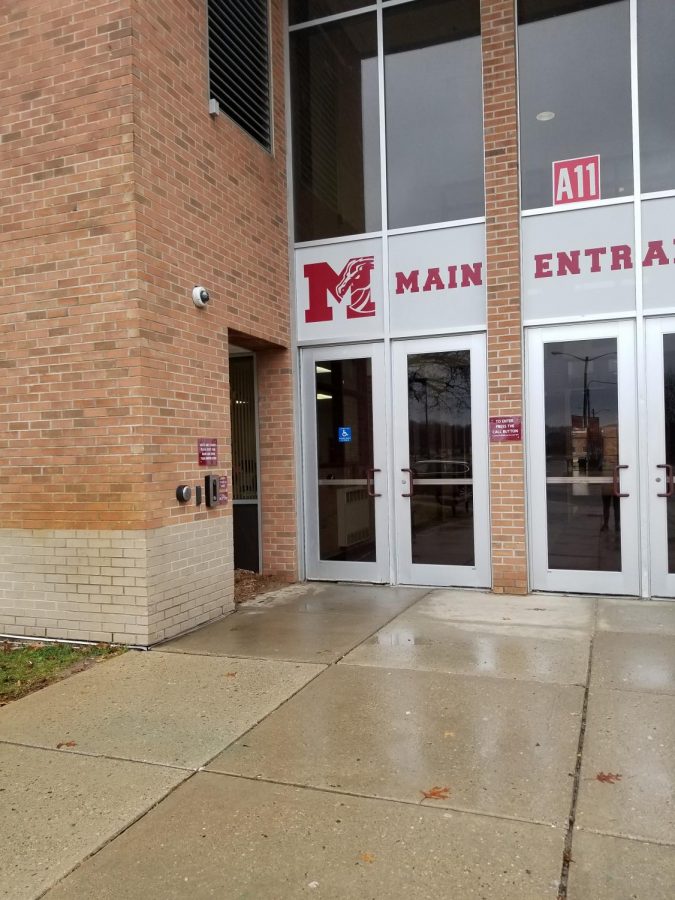HVS Bond & Sinking Millage Fund passes with community support
Current entryway to Milford High School (Photo by Riley Coesens)
December 20, 2019
On Tuesday, Nov. 5th, voters flocked to polling locations to cast their opinions regarding the future of Huron Valley Schools.
Two proposals, both a bond and a building sinking fund, offered voters a chance to support the schools financially without a tax increase.
Individuals from Milford, Highland, Commerce, and White Lake Townships overwhelmingly checked the “yes” boxes, ensuring schools will be provided with financial resources for years to come.
The $182 million bond easily passed with 72 percent in favor of it.
With the public’s reinforcement, HVS schools secured vital finances to upgrade security, technology, buses, and land acquisition, as well as other assets specific to each school, such as playgrounds and athletic facilities — many of which are in dire need of replacement or upkeep.
This part of the ballot passed with 9,850 to 3,737, according to the Oakland County clerk website.
The Building Site Sinking Fund also passed easily, with 10,402-2,993.This form of financial support will be used for district real estate construction and repairs over the next 10 years, at a consistent millage rate of 7.9109.
HVS Superintendent Dr. Paul Salah is one of many who was thankful for the bond and millage’s passing.
He described Huron Valley’s current status of upkeep, due to lack of funding, as “[Using] the Band-Aid approach, trying to keep buildings limping along.”
With additional funds allocated to the district, Huron Valley can now provide better resources and opportunities to succeed. “There is an ongoing cost for enhancements, infrastructure, etc. that need to be sustained and maintained… money is needed to accomplish all of those changes, and more,” said MHS Principal Kevin McKenna.
Some specific changes at Milford High School include improving the athletic facilities, expanding the band area and purchasing new equipment, and program enhancements and experiences , such as for STEM and elective classes that will, “Make sure kids have the tools to learn,” said McKenna.
Salah also mentioned increasing the focus on project-based learning and operational opportunities for students, starting with a change in furniture, in order to encourage flexibility and collaboration on a larger and more consistent scale within classrooms.
Advocates of the proposals recognized the value of the bond passing, starting with “cosmetic improvements” that each school is in desperate need of.
“Students and staff in HVS deserve to have well maintained buildings in which to do their jobs–learning and teaching. Having a leaky ceiling in a classroom, for instance, is a distraction to being able to effectively do those very valuable jobs,” said Jen Cawthorne, a parent and supporter.
MHS Parent Erin Sarafa agreed, explaining how overdue these changes are, particularly in classrooms, bathrooms, and in hallways. Sarafa is active within the schools, and her children have been involved in many MHS athletics.
Both McKenna and Salah said these upgrades will boost HVS’ impact on the area, making it more competitive with other districts.
“We have to keep up with the times to help kids have the best opportunity to education… also, we have to raise the bar to keep [surrounding schools] engaged to make us a better district,” he explained. “This is just the beginning of our use of strong technology and much-needed upgrades to improve our students’ futures.”
Salah agreed: “Having healthy schools creates a healthy community.”
Cawthorne expressed similar views, especially in regards to the bond’s impact outside of HVS.
“The HVS community needs to show that we respect the education happening in our schools by passing these bonds,” she stated. “Improving the condition of the schools helps how our entire community is viewed, and as a result increases housing values and makes it a more desirable place to live.”
However, this process is not instant; widespread change cannot happen overnight, even within the minds of prepared students, parents, and staff. It takes time to transform a school with run-down amenities. In MHS specifically, modifying the security and entryway is first and foremost, in addition to smaller, quick renovations.
According to Salah, the following upgrades will occur first at Milford: cement work in front of MHS and on Watkins Blvd, as well as repairs to the parking lot; replacing stadium turf at both high schools; boiler and chiller replacement and maintenance (2020); and a safer, secure entryway (2021). These will begin as soon as this spring and summer of 2020, and continue into future school years.
Later, the more noticeable improvements will prevail, revealing the numerous benefits of the proposals’ passing. Further planning and budgeting will reveal a closer look into the scheduling and progress on updates within each building needing advancement.
In order to reap the most benefit from allocated finances for each school, including MHS, upgrades must be discussed and prioritized before final decisions can be made. Not all voters agreed with the proposals, but as said by McKenna, “We can learn from and respect their voices on the cause.”
He described this as a positive learning experience for all, as it gives those with contrasting views the opportunity to educate themselves, ask questions, and understand another person’s views.
Regardless, he and all of Huron Valley Schools staff thank each and every voter who took a stance on the proposals.
Dawn Grigereit, parent and advocate for MHS and the community, captured hers and others’ opinions, simply stating,
“Not voting is not a statement. It’s rendering yourself invisible. It is silencing your own voice. It is self-marginalization. It’s allowing your future to be determined by other people and pretending that’s a victory.”
